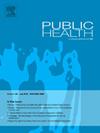Unveiling hidden cases: Hospital screening as a proxy for SARS-CoV-2 incidence in the general population
IF 3.2
3区 医学
Q1 PUBLIC, ENVIRONMENTAL & OCCUPATIONAL HEALTH
引用次数: 0
Abstract
Objectives
During the COVID-19 pandemic, SARS-CoV-2 incidence served as a critical metric for monitoring the epidemiological situation and guiding public health policies. However, as testing requirements and strategies evolved throughout the pandemic, an increasing number of SARS-CoV-2 infections may have remained undetected. This study investigates alternative indicators for estimating unreported SARS-CoV-2 infections.
Study design
This study uses a retrospective observational approach, analysing SARS-CoV-2 incidence data from different population groups to determine correlations and identify potential proxy indicators for incidence in the general population.
Methods
Monthly SARS-CoV-2 incidence rates from January 03, 2020 to April 30, 2023 in the general Bavarian population were compared with incidence rates among three reference populations at a Bavarian tertiary care hospital: healthcare workers (HCWs), inpatients, and visitors. Correlations and cross-correlations were calculated to assess the potential of these datasets as proxies for estimating general population incidence.
Results
The general population reported incidence was highly correlated with the HCWs (r = 0.84) and the inpatient incidence (r = 0.81), while visitor incidence exhibited a weaker correlation (r = 0.35). Restricting analysis to data up to March 2022 – used as a reference point after which the general population reported incidence consistently fell below the indicator-based incidences – the correlations increased for HCWs (r = 0.92) and inpatients (r = 0.92).
Conclusions
The 2022 reversal of incidence data indicates an underreporting of SARS-CoV-2 infections. Screening data from tertiary care hospitals are an important public health strategy for estimating current incidence rates, especially in the post-pandemic period, even when case monitoring is stopped or decompensated. Incidence rates among HCWs and inpatients in low-threshold testing environments are reliable proxies for general population reported incidence, offering valuable insights into SARS-CoV-2 and other acute respiratory viruses in the post-pandemic era.
揭露隐藏病例:医院筛查作为普通人群中SARS-CoV-2发病率的代表
目的在2019冠状病毒病大流行期间,SARS-CoV-2发病率可作为监测流行病学形势和指导公共卫生政策的重要指标。然而,随着整个大流行期间检测要求和策略的演变,越来越多的SARS-CoV-2感染可能仍未被发现。本研究探讨了估计未报告的SARS-CoV-2感染的替代指标。本研究采用回顾性观察方法,分析来自不同人群的SARS-CoV-2发病率数据,以确定相关性并确定普通人群发病率的潜在代理指标。方法将2020年1月3日至2023年4月30日巴伐利亚普通人群每月SARS-CoV-2发病率与巴伐利亚三级医院医护人员、住院患者和访客3个参考人群的发病率进行比较。计算相关性和交叉相关性,以评估这些数据集作为估计一般人群发病率的代用指标的潜力。结果普通人群发病率与住院患者发病率呈高度相关(r = 0.84),与住院患者发病率呈高度相关(r = 0.81),与来访患者发病率呈弱相关(r = 0.35)。将分析限制在截至2022年3月的数据上——作为参考点,此后一般人群报告的发病率一直低于基于指标的发病率——医护人员(r = 0.92)和住院患者(r = 0.92)的相关性增加。结论2022年发病率数据逆转提示SARS-CoV-2感染少报。来自三级保健医院的筛查数据是估计当前发病率的一项重要公共卫生战略,特别是在大流行后时期,即使在病例监测停止或失代偿的情况下也是如此。低阈值检测环境中卫生保健工作者和住院患者的发病率是一般人群报告发病率的可靠指标,为了解大流行后时代的SARS-CoV-2和其他急性呼吸道病毒提供了有价值的见解。
本文章由计算机程序翻译,如有差异,请以英文原文为准。
求助全文
约1分钟内获得全文
求助全文
来源期刊

Public Health
医学-公共卫生、环境卫生与职业卫生
CiteScore
7.60
自引率
0.00%
发文量
280
审稿时长
37 days
期刊介绍:
Public Health is an international, multidisciplinary peer-reviewed journal. It publishes original papers, reviews and short reports on all aspects of the science, philosophy, and practice of public health.
 求助内容:
求助内容: 应助结果提醒方式:
应助结果提醒方式:


